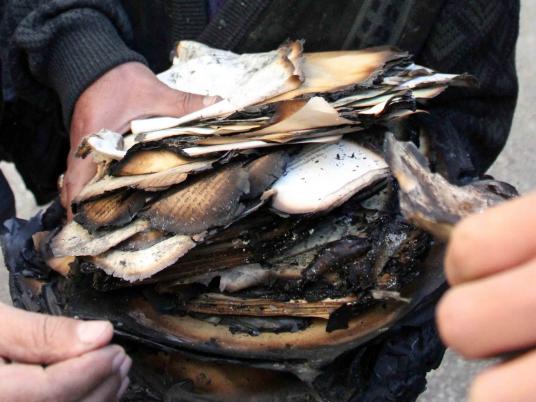
Not only has Egypt’s cultural heritage been victim to recent political instability, several state bodies have shown scientific research has also taken a big hit. In addition to looting of monuments and archaeological establishments, two research centers have been burned: at Cairo University’s Faculty of Engineering and at Orman Garden’s. Two weeks after dispersal of sit-ins and protests by supporters of ex-President Mohamed Morsy, science and history have been at whim of those making political choices, who often have little regard for studying the impact of the violence or confronting it.
For over two weeks, Ahmed abdel Fattah and his colleagues have been cleaning the building of ashes and burnt papers. As they remove a pile of ashes, a fire was quickly rekindled in the same pile of debris. Workers try to extinguish it with water but it takes only few hours for the fire to engulf the same pile all over again. “Everyday in the morning we remove the ashes only to find that a fire was restarted from the pile beneath. We put it out with water, then the fire starts again after few hours. A fire will start from the ashes every day until it will have gutted everything in the building,” abdel Fattah said impatiently.
“Books, documents, air conditioners, computers and everything was on fire for one week,” he added.
Ashes cover the ground on the third floor. The odor still lingered in the air. Only pillars on the third floor of the faculty’s administrative office remain. Flames can be seen everyday. Civil protection forces tried to rescue the panel that reads ‘Cairo University- Faculty of Engineering.. established in 1905’
Before the Giza governorate office, which Morsy supporters burnt and used to post his portrait, there stood several vehicles loaded with new wooden boards with the hope that they could keep the building standing until it would be renovated following the fires that started in several places in the country on 16 August during protests of Morsy supporters.
Dozens of workers were standing around the building in a similtar scene as a week earlier when protesters were on site.
“Where is your helmet? How can you go inside without it? You are in danger and prone to anything that could fall on you,” we heard while entering into the debris of the governorate building which was established by end of the nineteenth century. Only few papers and an outdoor structure about ready to collapse remained after the fire.
Old paintings and hanged carpets inside the governor’s office as well as the internal stairs were found, according to Mohamed Saad, a security personnel who has been in charge of securing the building for more than two years. “We couldn’t protect the building as security inside the building was not enough, which enabled number of Morsy supporters to storm and burn it.”
Despite the end of official working hours, the main gate of Orman garden built in 1875 that overlooks the Nahda Square was still opened, not by the garden’s administration or the visitors, but by an armored vehicle that could not find any other way to end the Islamists’ sit-in staged inside the garden other than crashing into historic gate, according to eyewitnesses.
On the ground facing the administration office, several workers of Agriculture Ministry’s maintenance sector were collecting parts of the smashed gate.
It wasn’t only the iron gate that was ruined due to the dispersal of the sit-in inside the garden. In a statement, the ministry preliminarily estimated losses of LE100 million at the rare plant garden.
Edited translation from Al-Masry Al-Youm




